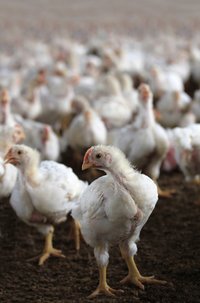



What does it mean for a broiler chicken to have reduced walking ability?
Aarhus University researchers have studied what it means for broiler chickens to have reduced walking abilities without actually being lame.
In recent decades, broilers’ walking abilities have changed as a result of the intensive selection for fast growth, high feed efficiency and increased final weight. The study from the Department of Animal Science, Aarhus University, shows that broilers with relatively minor changes in gait (not being lame as such), showed an increased level of inactivity e, were less mobile and had a higher occurrence of abnormal behaviour compared to birds of normal gait.
Gait assessment in broilers
When broilers’ walking abilities are assessed, the Bristol-scale with scores from 0 to 5 is typically used. A gait score of 0 (GS0) is equivalent to birds of normal gait while GS5 birds are unable to walk. In the broiler industry and the scientific literature, GS3-5 birds are categorised as lame while the scores GS1-2 describes reduced walking abilities without actual lameness. Despite GS1-2 being among the most frequent scores in flocks of conventional broilers, only few studies have focused on this group.
Study of GS2-chickens at Aarhus University
With senior researcher Anja Brinch Riber in the lead, a study has been conducted at Department of Animal Science, Aarhus University, for better understanding how reduced walking abilities affect the birds – in this case by comparing behaviour of GS2 chickens (all Ross 308) to behaviour of comparable birds of normal gait. The project has included observation of undisturbed behaviour in the home environment, mobility tests, and included health data collected at slaughter.
“We don’t often have the opportunity to study broiler welfare by following the same individual over time. We were able to do so in this project, which is why this is an atypical project, contributing with new knowledge about for example changes in walking abilities over time and coherence between different welfare indicators in the same individuals. Our experimental birds were housed under conditions resembling the conditions in practice during the first three weeks of their life in order to model reality in the best possible way”, explains Anja B. Riber.
Less mobility and increased abnormal behaviour in GS2 chickens
The results of the study show clear differences between GS0 and GS2 birds in relation to mobility and undisturbed behaviour. GS2 birds were less mobile, more inactive and showed more abnormal behaviour such as feeding while sitting. In addition, GS2-birds showed less natural behaviour such as the use of perches and comfort behaviour. These results show that GS2 can be of importance to the welfare of the birds.
Besides studying behavioural differences in birds scored GS0 and GS2, effects of the sex and effects of treatment with the analgesic drug carprofen were included in the study. Carprofen is a non-steroidal anti-inflammatory drug, previously used in studies of mobility and pain in broilers.
“It may seem strange to give an analgesic drug to animals if you don’t know whether they are in pain, but comparing responses of animals treated with analgesic drugs versus control animals is a classic method to document whether pain is involved”, explains senior researcher Mette S. Herskin, who participated in the study. “If the animals change their behaviour after administration of an analgesic drug, it suggests that pain may be involved. A similar method has been used to study pain for example in relation to castration of piglets and dehorning of calves”, she explains.
The comparison of broilers with and without administration of analgesic drugs showed that carprofen affected the undisturbed behaviour, resulting in increased physical activity. Importantly, however, the effects of carprofen did not depend on the gait score of the birds. Hence, these results may indicate that broilers in general can be behaviourally limited due to pain, but it should be kept in mind that carprofen may have other effects than pain relief and that additional studies thus are needed for further clarification.








